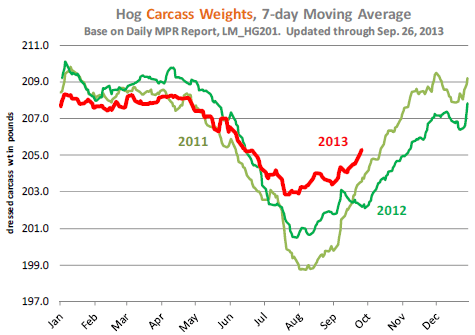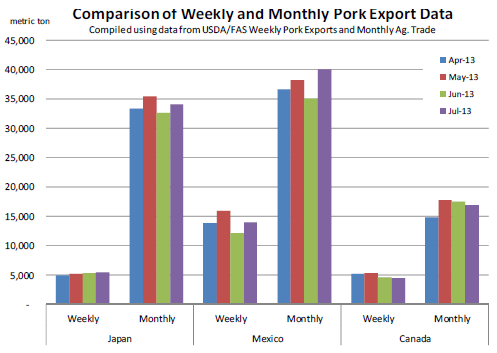



CME: Pork Exports to Remain a Critical Driver for Demand
US - The pork cut-out continued to climb on tight pork supplies and the likelihood that packer slaughter will continue to track well below year ago and five-year average levels in the short term, write Steve Meyer and Len Steiner.The pork cutout was quoted at $102.36/cwt on Thursday evening, a whopping 28 per cent above year ago levels and also 4 per cent higher than what it was at the same time in 2011. Comparisons to a year ago are somewhat skewed by the impact that high feed costs had on pork supplies last year.
Producers last year sought to limit the red ink from the spike in grain prices and weekly hog slaughter in the first two weeks of September 2012 was one of the highest on record - ever - and this helped push down hog and pork prices temporarily. The reverse appears to be taking place this year.
Hog slaughter in the last three weeks has averaged 2.1 million head, 8 per cent lower than a year ago and 4.5 per cent lower than the five year average. The shortfall in hogs has caught some end users by surprise. The shortfall in slaughter also has provided some support for items that seasonally do well at this time of year.
The ham cutout is currently up 26 per cent from a year ago and 1 per cent higher than in 2011. By far the biggest contributor to the increase is the dramatic growth in demand for pork bellies. The demand curve for bacon appears to have shifted decidedly in recent years and it is a big part of the reason why overall pork and hog prices are holding at current levels.
Consider the following: The pork cutout current is up $22.08/cwt compared to a year ago and higher belly prices have contributed about $7.54 to that growth. So while bellies are 16 per cent of the carcass, they account for 34 per cent of the growth. Comparisons to 2011 are even more dramatic. Current cutout values are up about $4.28/cwt compared to 2011. The gains in belly prices have contributed about $7.41/cwt to that growth. In other words, the increase in belly prices this year vs. 2011 has more than offset the declines in other primals.

So where do hog and pork prices go from here? There appears to be increasing evidence that hog supplies on the ground are tighter than earlier expected. In part this reflects the effects that poor forward margins and high feed costs had on producers early last spring.
USDA issued the results of its quarterly survey and the expectation was that USDA will go back and revise some its pig crop estimates for previous quarters, especially the Mar - May quarter. Futures have rallied higher as more evidence has come forward of tight supplies on the ground. However, hog weights are quickly trending up and with freshly harvested corn becoming available and cooler temperatures, the expectation is that those weights will continue to climb.
The increase in weights (+1.4 per cent vs. yr ago at this point), will offset some of the decline in slaughter. At this point there is no strong indication form the weight data that producers may be falling behind in their marketings. It is something that bears watching, however, as we go forward.
Then there is the issue of pork demand, especially export demand. In the past we have mentioned that now USDA is providing a weekly tracking report for weekly export sales. At this point, the weekly export numbers only represent about 30 per cent of overall exports, so the signals provided by that report should be viewed with caution. Suffice to say, that with one out of five pounds of pork going to export at this point, this will remain a critical driver for demand in the coming months.








